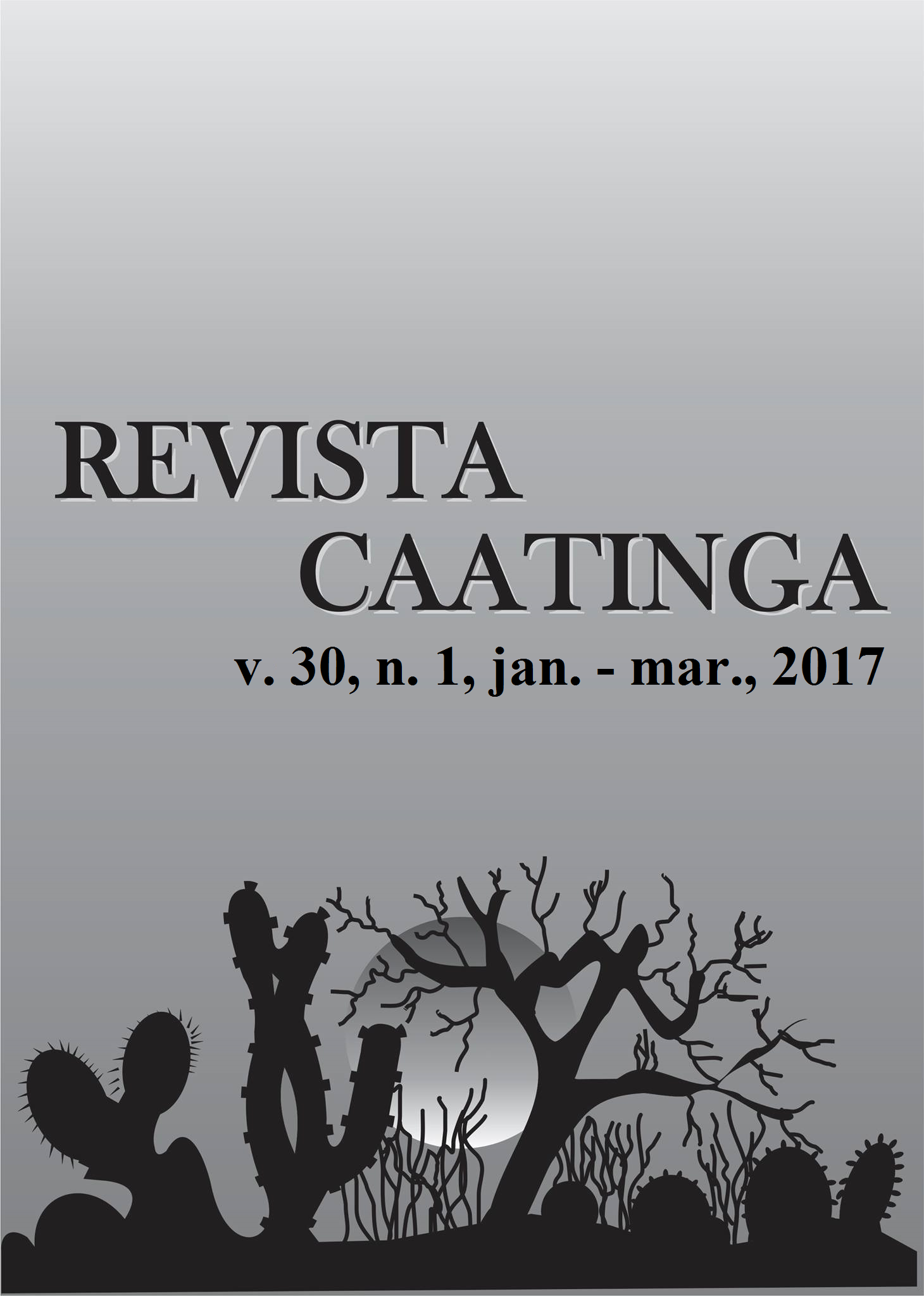COWPEA GROWTH AND YIELD IN SOLE CROP AND INTERCROPPED WITH MILLET
DOI:
https://doi.org/10.1590/1983-21252017v30n106rcKeywords:
Vigna unguiculata (L.) Walp. Penisetum glaucum (L.) R. Brown. Yield. Land-use efficiency index.Abstract
The objective of this work was to evaluate the growth and yield of cowpea grains in different intercropping systems with millet, in wet and dry seasons. The experiments were performed in the experimental field of the Department of Plant Science of the Federal Rural University of Rio de Janeiro, Brazil, using a randomized block design with three replications and five treatments: T1- sole crop of millet; T2- sole crop of cowpea; T3- intercrop of millet (1 row) and cowpea (1 row) with 0.5 m between rows (1Mx1C-0.50); T4 - intercrop of millet (1 row) and cowpea (1 row) with 0.75 m between rows (1Mx1C-0.75); and T5 - intercrop of millet (1 row) and cowpea (2 rows) with 0.5 m between rows (1Mx2C-0.50). The cowpea shoot dry weight, root dry weight, number and dry weight of nodules, grain yield and 1000-grain weight, and the millet fresh weight, shoot dry weight, grain yield and 1000-grain weight were evaluated. The land-use efficiency index (LUE) showed significant differences in yield between the sole crop of cowpea and the intercropping system, with greater grain weight in the intercrop 1Mx2C-0.50. On the other hand, the intercrop 1Mx1C-0.75 was not recommended for the study conditions.Downloads
References
ASIWE, J. A. N. Insect mediated outcrossing and gene flow in cowpea (Vigna unguiculata L. Walp): Implication for seed production and provision of containment structures for genetically transformed cowpea. African Journal of Biotechnology, Nairobi, v. 8, n. 2, p. 226-230, 2009.
COSTA, A. C. T. et al. Unidades térmicas e produtividade de genótipos de milheto semeados em duas épocas. Pesquisa Agropecuária Brasileira, Brasília, v. 40, n. 12, p. 1171-1177, 2005.
EMBRAPA. Centro Nacional de Pesquisa de Solos. Sistema brasileiro de classificação de solos. 3. ed. Brasília, DF: 2013. 353 p.
FERREIRA, D. F. Sisvar: A computer statistical analysis system. Ciência e Agrotecnologia, Lavras, v. 35, n. 6, p. 1039-1042, 2011.
FLESCH, R. D. Efeitos temporais e espaciais no consórcio intercalar de milho e feijão. Pesquisa Agropecuária Brasileira, Brasília, v. 37, n. 1, p. 51-56, 2002.
GERALDO, J. et al. Fenologia e produção de massa seca e de grãos em cultivares de milheto-pérola. Pesquisa Agropecuária Brasileira, Brasília, v. 37, n. 9, p. 1263-1268, 2002.
GERALDO, J. et al. Herdabilidade e correlações genéticas do teor e da aquisição de nitrogênio em milheto pérola. Revista Universidade Rural, Série Ciências da Vida, Seropédica, v. 22, n. 2, p. 61-70, 2003.
KAUSHIK, S. K.; GAUTAM, R. C. Response of rainfed pearl millet (Pennisetum glaucum) to water harvesting. Moisture conservation and plant population in light soils. Indian Journal of Agricultural Sciences, New Delli, v. 64, n. 12, p. 858-860, 1994.
LEITE, M. A.; FILHO, J. S. V. Produção de matéria seca em plantas de caupi (Vigna unguiculata (l.) Walp) submetidas a déficits hídricos. Ciências Exatas e Terra, Ciências Agrária e Engenharias, Ponta Grossa, v. 10, n. 1, p. 43-51, 2004.
MELO, F. B. et al. Fertilidade do solo e adubação. In: FREIRE FILHO, F. R. et al. (Eds.). Feijão-caupi: avanços tecnológicos. Brasília: Embrapa, 2005. p. 231-242.
MOHAMMED, I. B. et al. Productivity of Millet / Cowpea Intercrop as Affected by Cowpea Genotype and Row Arrangement. World Journal of Agricultural Sciences, Zaira, v. 4, n. S, p. 818-824, 2008.
NECHET, K. L.; HALFELD-VIEIRA, B. A. Reação de cultivares de feijão-caupi à mela (Rhizoctonia solani) em Roraima. Fitopatologia Brasileira, Brasília, v. 32, n. 5, p. 424-428, 2007.
PAYNE, W. A. Optimizing crop water use in sparse stands of pearl millet. Crop Science, Madison, v. 92, n. 5, p. 808-814, 2000.
PIMENTEL, C. Efficiency of nutrient use by crops for low input agro-environments. In: SINGH, R. P. et al. (Eds.). Focus on plant agriculture: 1 Nitrogen nutrition in plant productivity. Houston: Studium Press, 2006. p. 277-328.
POLTRONIERI, L. S.; TRINDADE, D. R.; SILVA, J. F. A. F et al. Principais doenças do feijão-caupi (Vigna unguiculata L. Walp.) no Pará e recomendações de controle. 1. ed. Belém, PA: Embrapa CPATU, 1994. 24 p. (Documentos, 75).
RUMJANEK, N. G. et al. Fixação biológica do nitrogênio. In: FREIRE FILHO, F.R. et al. (Eds.). Feijão-caupi: avanços tecnológicos. Brasília: Embrapa, 2005. p. 281-335.
SANTOS, J. F. et al. Produção e componentes produtivos de variedades de feijão caupi na microregião cariri paraibano. Engenharia Ambiental, Espírito Santo do Pinhal, v. 6, n. 1, p. 214-222, 2009.
SPRENT, J. I. et al. African legumes: a vital but under-utilized resource. Journal of Experimental Botany, Oxford, v. 61, n. 5, p. 1257–1265, 2010.
TORRES, S. B. et al. Produtividade e morfologia de acessos de caupi, em Mossoró, RN. Horticultura Brasileira, Brasília, v. 26, n. 4, p. 537-539, 2008.
VALADÃO, F. C. A. et al. Inoculação das sementes e adubações nitrogenada e molíbdica do feijoeiro - Comum, em Rolim de Moura, RO. Acta Amazonica, Manaus, v. 39, n. 4, p. 741-748, 2009.
VIEIRA, C. O feijão em cultivos consorciados. 1. ed. Viçosa, MG: UFV, 1989. 134 p.
Downloads
Published
Issue
Section
License
Os Autores que publicam na Revista Caatinga concordam com os seguintes termos:
a) Os Autores mantêm os direitos autorais e concedem à revista o direito de primeira publicação, com o trabalho simultaneamente licenciado sob a Licença Creative Commons do tipo atribuição CC-BY, para todo o conteúdo do periódico, exceto onde estiver identificado, que permite o compartilhamento do trabalho com reconhecimento da autoria e publicação inicial nesta revista, sem fins comerciais.
b) Os Autores têm autorização para distribuição não-exclusiva da versão do trabalho publicada nesta revista (ex.: publicar em repositório institucional ou como capítulo de livro), com reconhecimento de autoria e publicação inicial nesta revista.
c) Os Autores têm permissão e são estimulados a publicar e distribuir seu trabalho online (ex.: em repositórios institucionais ou na sua página pessoal) a qualquer ponto antes ou durante o processo editorial, já que isso pode gerar alterações produtivas, bem como aumentar o impacto e a citação do trabalho publicado (Veja O Efeito do Acesso Livre).







